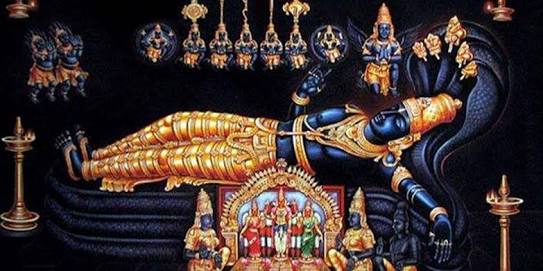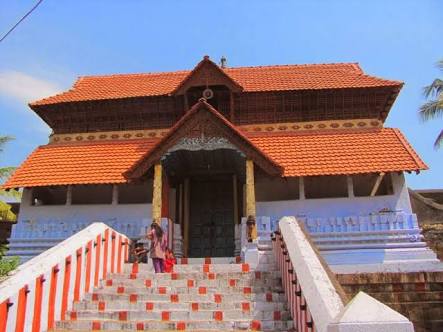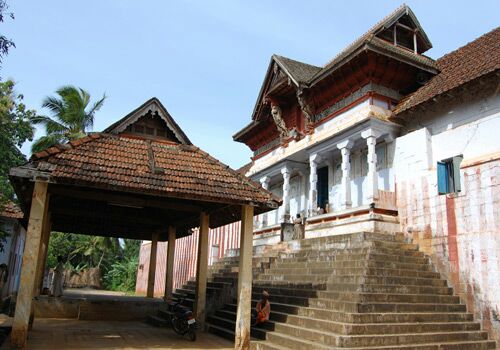Sree Adikesava Perumal Temple, situated in Thiruvattar in Tamil Nadu (formerly a part of southern Kerala), has been in existence for circa two and half thousand years. It is one of the 108 Vaishnava temples, Divya Desam, in India. However, during recent past its significance has become understated. The Deity is an incarnation of Lord Vishnu, Ananthasayanam, as Lord Adikesava he is in recumbent pose (Yoganidra), with eyes closed dreaming of manifesting the universe whilst reclining on the coiled body of the Serpent King, Adiseshan, who is a symbol for the beginning of time.
According to the Puranas, Lord Brahma performed a Yaga without Saraswathi Devi, as a result of Saraswathi’s anger two asuras, Kesan and Kesi emerged out of the sacrificial fire, these asuras troubled the Three Worlds. The Devas approached Vishnu for a solution. Following an almighty battle Lord Mahavishnu in the form of Kesava, Perumal defeated Kesan, and then to secure him Adiseshan coiled around him. This is how Lord Kesava Perumal became known as ‘Adi Kesavan’. The second asura Kesi, who had seen her brother Kesan defeated, wanted revenge and with her friend, Kothai they both took the form of rivers and surrounded the temple with the intention of submerging it. Bhoomi Devi (the earth Goddess) raised the temple away from the waters, and today the temple is surrounded by the rivers Parali and Kotha and stands at a height of 55 feet from ground level. The Puranas say ‘the rivers’ repented and were forgiven, then Perumal had a dip in Moovaatru Mukham, the place where the rivers joined with the Arabian sea and even today, during Painguni Utsavam, Perumal comes on a golden Garuda for a dip in the river, re-enacting the Shapa Vimochana incident. Thiruvattar Temple is orbited by a protective necklace of Shivalingams, and in March, during Mahasivarathri, pilgrims visit these shrines chanting ‘Govinda’, Lord Vishnu’s name. The famous Shivalaya Ottam is said to be only complete when the devotees end their trip in the Perumal temple. There are too many sacred associations and agamas to mention here but scholars and devotees may approach the temple for further discovery.
Typically a temple is built around a gigantic single block Mandapam stone on which the Vigraham/ idol is placed. The earthly representation of Adikesava is constructed as the human body, a Karungali wood framework forms his skeleton, a concoction of coconut husks adheres to the skeleton representing the nervous systems and 16,008 strategic Shaligrama stones from Nepal replicate his organs and his human form. His skin has seven applications of Kadusharkara Kalkam polished to perfection. His visions of evolution from fish to horseman are manifested in stone on the southern wall of the Ottakkal Mandapam; the last two avatars, Buddha and Kalki are being repaired and will soon return to the northern wall. The daily poojas are performed in the Archana Vigrahas and the daily Abhishekas (bathing) of the Lord takes place at the Ottakal Mandapam. Inside the Sanctum Santorum are the symbols of the Sun, Moon and manifestations of the Discus and Mace, Vishnu’s weapons. These ancient carvings according to Purana wisdom demonstrate the cosmic science of Hindus. Artistic wooden carvings are all around the temple and there are infinite geographical, architectural, astrological, historical and literal references to the divinity of the idol.
In 2012, I was invited to visit the temple to say a prayer before Lord Adikesava. Worshiping besides the devotees was heartening, but it was clear that after so many years the temple structure and the idol needed some tender, loving care and investment. The devotional paintings from the Puranas on the outer wall of the Sanctum Sanctorum had become sadly dilapidated, as had many other features around the temple. The temple is a living example of traditions, one of the finest examples of early south Indian Vastu principled architecture and the best theological practise. A program for the restoration had been prepared by the Temple administration as early as 2002, a thoroughly business-like schedule of repair-works and their corresponding budget was also published. The repairs were scheduled in four phases breaking down into 28 stages but alas, since the estimates were prepared, the costs have tripled. Following some recent predictive astrological divinations, it was considered imperative that renovations begin; the repair work is conducted under the direction of Vastu expert Vezhaparambu Brahmadattan Namboothiri. The work began in 2014, the Kanyakumari Devasom Board sponsored the new copper tiles on the roof over the Moolasthanam and the Udaya Marthanda Mandapam of the Temple has been beautifully cleaned and painted. Further sponsorship was hard to come by, then a member of the Travancore Royal Family, Princess Lakshmi Bayi Nalapat stepped forward to help with a critical but complex repair, the rejuvenation of the idol of Perumal that is made of a mixture of materials called Kadu Sarkarai Yogam. The Royal Family of Travancore have a long association with Thiruvattar. Previously nearby Padmanabhapuram was the capital of the erstwhile State of Travancore and the Maharajas of Travancore were the sole persons permitted to prostrate in prayer on the Ottakal Mandapam. Adikesava Perumal is believed to be Anantha Padmanabha’s elder brother, the two idols recline is such a way that they actually face each other all the way from to Thiruvattar to Thiruvananthapuram. The spiritual connection between the two temples and the Royal Family has waned during the past fifty years, it is thanks to Princess Lakshmi Bayi Nalapat’s dedication that the bond has been revived.
Shri Madhu Pandit, the dynamic head of ISCKON, Bangalore, came to rescue the flagstaff (in 2012, ISKCON had renovated the Krishna Shrine in Thiruvattar). The old flagstaff was removed with due caution and ceremony then cremated with full honours. On a particularly auspicious date in 2016, the new 70+ foot teak flagstaff from the Konni forest in Kerala, about 120 miles away, was delicately lowered by crane into the temple complex, where it now awaits an 18 month marination in its purpose built trough filled with sesame oil.
In January 2018, by invitation I visited Thiruvattar again, and to say I was impressed is an understatement. The tender loving care and the devotional rituals carried out to sanctify and move Pancha Loha Abhisheka idol to his temporary shrine called Baalaalayam, meaning baby or little house have been recorded on video; the hymns, chants, bells, drums and flutes of the poojas show the sincerity of the administration. Every human effort possible was done to transfer the spirit of Adikesava and to make the Deity at home in his temporary chamber. The figure lying in the Sanctum Sanctorum lies benignly whilst under the expert hands of Brahmamangalam Kailasan who is repairing his seven layers of skin, Kadusharkara has a combination of 64 elements, varying in texture and adhesive properties. Each of the seven applications have a special Ayurvedic alchemy, the multiple ingredients are ground up by Kailasan and prepared in the homestead of the Manalikara Mathoor Thanthris. They are applied only by this experienced craftsman according to the agamas, and each layer is painstakingly applied by hand and takes 15 days to dry before the next layer can be applied. The storage and organization of the component ingredients, the procedure and the tidiness of the workshop were faultless, although the recipes remain secret.
The two Thanthris I met are from Manalikara Madom, Subramaniaru S and Sajith Sankaranarayanaru. The latter is also a law student. They explained over the kitchen table what a laborious process, renovation is. They are open about the methodology and absolutely particular about obeisance to the correct processes, conscious not to disturb the tranquillity of Adikesava’s meditation or the magnetic energy of the Mandapam stone and the infinite osmotic potential of the ritual herbs and essences used during thousands of years of poojas. The rituals followed here are according to the “Malayala Tantram” encoded in the “Tantra Samuchayam” from Guruvayur in C15th.
Presently the Tanthris have only reached Phase 1 stage 3, another 14.6Crore INR (£1.6 million GBP) needs to be sourced to complete these essential repairs. They are relying on their commitment and faith to mobilise the necessary funds. It is not insignificant that Vishnu is the preserver, these Tanthris want to preserve Adikesava and his ancient temple, to breathe new life and awe into the human environment of the area, they believe the health of the Vigraham reflects the health of their eco-system, which in turn is a microcosm of the health of all Indian culture. The local devotees are ordinary people whose modest effort helps with general maintenance; what this temple needs to continue the restoration is more genuine patrons, with the right sponsorship it is hoped that Adikesava will be re-clothed in his glorious golden robes.
All enquiries relating to Sree Adikesava Perumal Temple can be addressed to [email protected]
Disclaimer: The opinions expressed within this article are the personal opinions of the author. IndiaFacts does not assume any responsibility or liability for the accuracy, completeness, suitability, or validity of any information in this article.
Antonia Filmer is former British Vogue Fashion Editor, Home Furnishing Design Director of Laura Ashley Ltd., producer of Garden Operas for 10 years to benefit a children’s charity. Antonia is an inveterate traveller and is currently the London correspondent for The Sunday Guardian- India.




